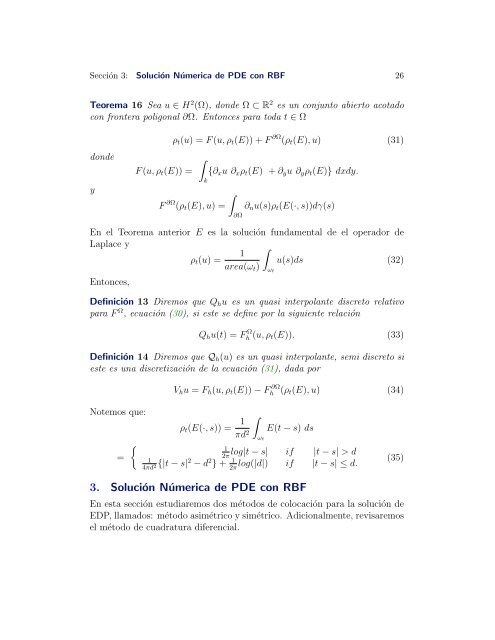Introducción a la teoría de Funciones Radiales - UNAM
Introducción a la teoría de Funciones Radiales - UNAM
Introducción a la teoría de Funciones Radiales - UNAM
Create successful ePaper yourself
Turn your PDF publications into a flip-book with our unique Google optimized e-Paper software.
Sección 3: Solución Númerica <strong>de</strong> PDE con RBF 26<br />
Teorema 16 Sea u ∈ H 2 (Ω), don<strong>de</strong> Ω ⊂ R 2 es un conjunto abierto acotado<br />
con frontera poligonal ∂Ω. Entonces para toda t ∈ Ω<br />
don<strong>de</strong><br />
y<br />
F (u, ρt(E)) =<br />
ρt(u) = F (u, ρt(E)) + F ∂Ω (ρt(E), u) (31)<br />
<br />
F ∂Ω <br />
(ρt(E), u) =<br />
k<br />
{∂xu ∂xρt(E) + ∂yu ∂yρt(E)} dxdy.<br />
∂Ω<br />
∂nu(s)ρt(E(·, s))dγ(s)<br />
En el Teorema anterior E es <strong>la</strong> solución fundamental <strong>de</strong> el operador <strong>de</strong><br />
Lap<strong>la</strong>ce y<br />
<br />
1<br />
ρt(u) =<br />
u(s)ds<br />
area(ωt) ωt<br />
(32)<br />
Entonces,<br />
Definición 13 Diremos que Qhu es un quasi interpo<strong>la</strong>nte discreto re<strong>la</strong>tivo<br />
para F Ω , ecuación (30), si este se <strong>de</strong>fine por <strong>la</strong> siguiente re<strong>la</strong>ción<br />
Qhu(t) = F Ω h (u, ρt(E)). (33)<br />
Definición 14 Diremos que Qh(u) es un quasi interpo<strong>la</strong>nte, semi discreto si<br />
este es una discretización <strong>de</strong> <strong>la</strong> ecuación (31), dada por<br />
Notemos que:<br />
=<br />
<br />
Vhu = Fh(u, ρt(E)) − F ∂Ω<br />
h (ρt(E), u) (34)<br />
ρt(E(·, s)) = 1<br />
πd2 <br />
E(t − s) ds<br />
ωt<br />
1 log|t − s| if |t − s| > d<br />
2π<br />
1<br />
4πd2 {|t − s| 2 − d2 } + 1 log(|d|) if |t − s| ≤ d.<br />
2π<br />
3. Solución Númerica <strong>de</strong> PDE con RBF<br />
(35)<br />
En esta sección estudiaremos dos métodos <strong>de</strong> colocación para <strong>la</strong> solución <strong>de</strong><br />
EDP, l<strong>la</strong>mados: método asimétrico y simétrico. Adicionalmente, revisaremos<br />
el método <strong>de</strong> cuadratura diferencial.


